
Horn Articles Online
A Tenor Horn/Alto Horn FAQ
What is a tenor horn?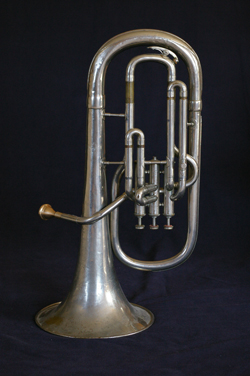
It is an alto range instrument pitched in E-flat that is used in British-style brass bands. It looks like a small Euphonium and is built to use a mouthpiece that is roughly half way between a cornet and a Euphonium mouthpiece, somewhat larger than a horn mouthpiece. It covers the same alto range that the French horn plays in.
I have also seen the German term
Tenorhorn, is that the same instrument?
No. It begins to get a bit confusing to an English speaker, but in German the term
Tenorhorn refers to an instrument pitched in B-flat similar to what we would think of as a baritone or Euphonium. In form they typically look a lot like a
tenor Wagner tuba but the mouthpiece is in a size range similar to that of a trombone or Euphonium mouthpiece and it is larger bore. Several orchestral works call for this instrument.
What then is an alto horn?
It has been said that the United States and England are two countries separated by a common language. In this case this is very true. Tenor horn is the British term and alto horn is the American term for more or less the same instrument.
I believe the first E-flat alto horn I ever saw was as a freshman in high school in 1975, at the University of Kansas band day. At that time some groups such as KU still used “American style” alto horns in marching band, which were built in the same pattern as a bell front Euphonium (sometimes called an "altonium") and were used as a substitute for horn. My high school did not use them but did own a pair of these which I borrowed to try at the time, and not long after I was given the instrument seen at the above right, a Buescher upright alto from around 1920. (A later "altonium" style instrument is below).
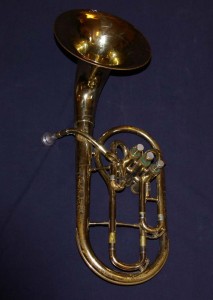 In terms of the United States as we start the 21st century the term tenor horn has become the predominant term among active players of the instrument in British-style brass bands, at least based on the rosters of players posted in the web sites of brass bands.
In terms of the United States as we start the 21st century the term tenor horn has become the predominant term among active players of the instrument in British-style brass bands, at least based on the rosters of players posted in the web sites of brass bands.
The term alto horn seems to be used more to refer to the older models of the instrument that were used in bands in general, not modern, British-style brass band instruments. These older instruments were typically a little smaller bore (especially around the neck of the bell), were mated with smaller bore mouthpieces, and blended a bit better with trumpets and trombones. Modern E-flat tenor horns in contrast tend to be a little larger bore and are designed to use larger bore mouthpieces. Tonally they are intended specifically to blend with modern cornets and Euphoniums in a brass band setting.
It should also be noted that a hundred years ago “Solo Altos” were also produced that were basically the same instrument but in a bell front design, not unlike modern marching mellophone, pitched in E-flat, and there are other European variations on the alto horn concept.
Who plays alto horn today?
Plenty of people play alto horns to some extent at home for fun, and there are always some for sale on eBay, but in terms of actual ensembles in the United States hardly anybody plays the classic E-flat alto anymore [but plenty of E-flat tenor horns are in use--see below--there has been a terminology shift, as noted above]. At one time altos had some serious use in bands, especially in brass bands in the middle and late nineteenth century. Over time tastes shifted toward the French horn as bands moved toward mixed brass and woodwind instrumentation, to the point that alto horns became viewed as a “poor cousin” of the French horn and were relegated to marching band. Many of them were still used in marching bands into the 1950s. This type of instrument is what many think of when they throw out the term "peck horn," as they were employed to "peck" along on off-beats in marches. Today they have today been completely replaced by
marching mellophones in these ensembles.
Who plays tenor horn today?
These are played quite a little bit still, as there are many British-style brass bands. The standard brass band has three E-flat tenor horns in the section, a “solo horn” and also first and second horn.
In the context of brass bands in the USA we see players come to the tenor horn from three sections in roughly equal numbers. Some players moved “down” from cornet (trumpet) and settled into tenor horn, either to help out in the middle register or perhaps due to changes in the chops associated with aging. Some players moved “up” from Euphonium, to help out in the middle range. And the rest of the players moved “over” from the French horn. In most cases it is an instrument learned later in life. Almost nobody starts on the tenor horn today, with the exception of players in the youth brass bands associated with the
Salvation Army.
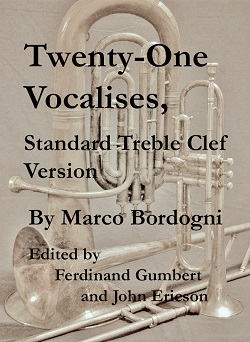 What
music can I play on a tenor horn?
What
music can I play on a tenor horn?
Much music will work well for
individual practice. Might I suggest trying the Standard Treble Clef version
of my edition of the Bordogni Vocalises? This edition and pitch level works
quite well on the tenor horn. More information at the links below:
Twenty-One Vocalises, Standard Treble Clef Version
Print version -- Kindle
Version -- Sample
Page
Why not use French horns in a brass band?
The tone of the tenor horn is different than the horn with a light, Euphonium-like quality, and it projects into a hall differently. The high range is roughly equally difficult on either instrument.
While there is the tradition of tenor horn playing and some advantages to the use of the tenor horn, a few brass bands in the United States actually do use French horns, such as the group I have performed with in Arizona,
The Salt River Brass.
What advantages does a tenor horn possess?
Better general accuracy is possible on tenor horn. As a shorter instrument with piston valves the tenor horn has more clarity of mid-range technique than the French horn. Also, other than the mouthpiece size adjustment, tenor horn is an easy instrument to learn for a trumpet or Euphonium player.
What downside is there to using a tenor horn?
Intonation is in general not as easy on tenor horn as on French horn, more notes require adjustment. For a French horn player many of the fingerings are different, and they all lay at a different pitch level which plays with the ear. Also the mouthpiece rim is quite different and, for the horn player, may not lay well on the lower lip.
What mouthpiece should I use?
In a modern, brass band context I would suggest the use of a British mouthpiece such as those by Dennis Wick. Their number 5 mouthpiece has an inner diameter very close to that of a standard horn mouthpiece and will play with the chops of doublers coming from the horn or trumpet the least. For a horn player attempting to play tenor horn the Dennis Wick 5 is the best choice. A slightly larger mouthpiece such as the Dennis Wick 2 would be great for more dedicated players or players coming from Euphonium. American-made mouthpieces such as the series by Bach were really made more for use on alto horn in a band and will tend to stick out tonally in a modern brass band context, the sound will be a little bright.
I should note that while you could actually use a horn mouthpiece with an adapter on tenor horn it really is not the right mouthpiece for the instrument. Also a marching mellophone mouthpiece will fit the receiver but is really, really not the right mouthpiece for tenor horn. But, for the adventurous, a small tenor horn mouthpiece works quite well on marching mellophone.
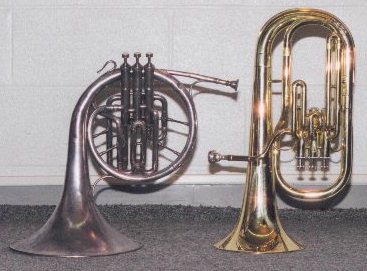 If it says "E-flat horn" in a part do they mean E-flat alto?
If it says "E-flat horn" in a part do they mean E-flat alto?
Sometimes--this can be the intention of the composer or arranger. However, it really depends on the context and composer.
Speaking broadly they are either looking for some type of short E-flat instrument such as an E-flat alto or mellophone or they are looking for a French horn crooked in E-flat, an octave longer instrument. It was common before 1900 especially to call for valved horns in keys other than F, and E-flat was very common.
ASU for example owns a classic piston valve French horn by Hawkes from this period that takes crooks. This photo is of a E-flat alto (Yamaha) and a classic King
concert mellophone.
Any great solo works written for the alto horn or tenor horn?
Yes! Hindemith wrote his alto horn sonata in E-flat for the alto/tenor horn. It is rarely played on the instrument today but it is by any standard a great work and arguably the best ever written for the alto/tenor horn.
Wait a minute, isn't the Hindemith for
Althorn? I am getting confused again.
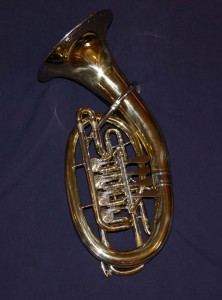 Yes. Actually the German term
Althorn is only a general term, the instrument could be made in one of four different forms in E-flat. To quote the
Groves article on the
Althorn,
Yes. Actually the German term
Althorn is only a general term, the instrument could be made in one of four different forms in E-flat. To quote the
Groves article on the
Althorn,
"It is used in brass bands in Germany, Switzerland and eastern Europe to fill the alto register and to supply off-beats. It is made in various shapes: 'trumpet-form', with the bell to the front; 'tuba-form', upright ...; and 'oval-form', which is the upright oval shape first seen in instruments of the early 1850s by Cerveny and is today a favourite form. The circular 'Waldhorn-form' is rarer. The mouthpiece is a deep funnel, wider than that of an orchestral horn."
The traditional mellophone illustrated earlier in this page is, like the "Waldhorn-form" circular alto mentioned above, a cousin of the alto horn/tenor horn. A circular alto looks even more like a horn at first glance as it is built with rotary valves. I believe though that Hindmith in fact had in mind the oval-form Althorn, here illustrated, which at a glance looks like a small Wagner tuba and would have been familar to him in the brass bands of his youth. They even saw some use in the United States as Mirafone marketed them here for a time for use in marching bands. I have a longer article on the topic of the Althorn here.